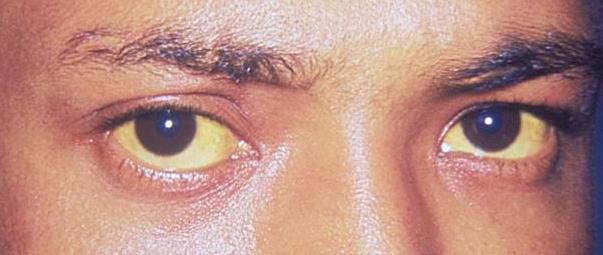Playlist
Show Playlist
Hide Playlist
Approach to Patients with Jaundice with Case
-
Slides Gastroenterology 16 Approach to Jaundice.pdf
-
Download Lecture Overview
00:00 Welcome. 00:01 Today we'll talk about the general approach to the patient with jaundice. 00:06 So we'll start with a case. 00:08 An 85-year-old woman is admitted to the hospital with fever, epigastric pain and jaundice. 00:14 She has no known history of liver or biliary disease. 00:17 Her vitals are notable for temperature of 39.3C and heart rate of 110 bpm. 00:23 Physical exam reveals jaundice and right upper quadrant tenderness without rebound or guarding. 00:29 No hepatosplenomegaly is noted. 00:31 Her labs reveal a white cell count of 20,000/uL, ALT 420 (U/L) AST 360 (U/L) and total bilirubin 8.5 (mg/dL) with a direct bilirubin of 6.8 (mg/dL). 00:45 Right upper quadrant ultrasound reveals dilated intra and extrahepatic bile ducts with gallstones but no findings of cholecystitis. 00:54 So what is the most likely diagnosis? To help us answer that question, let's look at some key features. 01:00 So she has fever, epigastric pain and jaundice. 01:04 This should prompt you to remember Charcot's triad of cholangitis. 01:09 In addition, on her physical exam and her labs , we note that she meet sepsis criteria with fever, tachycardia and a high white count. 01:18 likely from a biliary source given her elevation in her liver test. 01:23 She has hyperbilirubinemia with a pattern of hepatocellular injury as well. 01:29 And on her ultrasound, we see common bile duct obstruction from the dilation of the bile ducts likely from a gallstone but we're not sure yet. 01:39 So now let's talk about the concept of jaundice. 01:43 Jaundice is a clinical sign when there is a disorder in bilirubin circulation typically only seen once serum bilirubin is above 2.5-3 (mg/dL). 01:53 There are three potential causes including: abnormal bilirubin metabolism, hepatocellular dysfunction and biliary obstruction. 02:04 So, there's a lot of terminology involved with discussing hyperbilirubinemia. 02:10 We'll have to first recall that bilirubin is conjugated in the liver for then excretion. 02:17 So labs may report a total bilirubin and they may also report a fractionated bilirubin as either direct or indirect bilirubin. 02:27 What do these terms mean? So, a direct bilirubin refers to conjugated bilirubin. 02:34 So that is bilirubin that has already been conjugated by the liver. 02:38 Whereas indirect bilirubin refers to unconjugated bilirubin so before it has reached the liver for conjugation. 02:48 It is helpful to think about jaundice in several large categories so we can think about it first in causes that occur before we get to the liver so prehepatic. 02:59 We may talk about causes within the liver, so intrahepatic. 03:03 And lastly posthepatic or after the liver. 03:07 So prehepatic causes tend to be from hemolysis or the breakdown of red blood cells. 03:14 Intrahepatic causes maybe from viral hepatitis, cirrhosis, or tumors or malignancies within the liver. 03:23 And posthepatic causes tend to be from gallstones or different types of cancer. 03:32 So in your initial approach to working up a patient with jaundice, these are some lab studies that you should make sure to get. 03:39 The first is your liver panel. 03:41 So this includes your AST, ALT, total and fractionated bilirubin, alkaline phosphatase, total protein and albumin. 03:50 Note that you may also want to get a GGT or gamma glutamylytanspeptidase. 03:56 This is a more specific test than alkaline phosphatase because it is more specific to the hepatobiliary system whereas alkaline phosphatase can be elevated from other conditions involving the bone. 04:09 You should also get a complete blood count or a CBC. 04:12 This is specifically to look for evidence of hemolysis by which you may see anemia. 04:19 You should also check your coagulation studies, again this is to look for potential signs of liver dysfunction. 04:26 And lastly, an abdominal ultrasound is helpful to look for any signs of obstruction. 04:32 So, there are many different ways to think about the diagnostic approach to hyperbilirubinemia. 04:38 This is one way that I think about it. 04:40 So when you're faced with high bilirubin, you can break it down into either an isolated elevation of the bilirubin or an elevation of a bilirubin along with an abnormal liver test. 04:53 When you have an isolated bilirubin elevation, you can break it down into whether it's unconjugated or mostly conjugated. 05:01 If it is mostly unconjugated, this is indirect bilirubin, your causes include hemolysis and other syndromes like Gilbert Syndrome and Crigler-Najjar. 05:13 If it is mostly conjugated which remember, is direct bilirubin then your causes are simply things like Dubin-Johnson or Rotor Syndrome. 05:23 On the other hand, if you also have abnormal liver chemistry test, then we can break it down into either a hepatocelllular pattern or a cholestatic pattern. 05:33 In the hepatocellular pattern, your causes are quite extensive but include viral hepatitis, drug-induced liver injury, autoimmune hepatitis and inherited conditions like Wilson's and alpha-1 antitrypsin and hemochromatosis. 05:48 On the other hand, and within the cholestatic pattern of elevation, you will have things like: gallstones, medications, PSC and PBC, cholangitis and various cancers or infiltrative diseases. 06:02 So now, let's go back to our prehepatic causes The mechanism by which people develop prehepatic jaundice is from metabolism of heme in the red blood cells. 06:14 So as red blood cells get destroyed by hemolysis, they then have breakdown of hemoglobin which then leads to production of bilirubin. 06:24 Remember again, this is unconjugated, indirect bilirubinemia because this is prior to transport to liver where the bilirubin will be conjugated and excreted. 06:37 So, there are many different types of hemolysis. 06:40 We can break them down in several large categories. 06:43 First you may have a defect in your red blood cell membrane as in G6PD deficiency or spherocytosis. 06:51 You may have a problem with the hemoglobin structure itself as in sickle cell disease or thalassemias. 06:58 And then there are other miscellaneous causes such as autoimmune hemolytic anemia or a large category of microangiopathic hemolytic anemias. 07:08 You may have resorption of a large hematoma or various medications can also induce hemolysisp Now let's move to our intrahepatic causes. 07:21 So these are... there are very many intrahepatic causes of cholestasis including viral hepatitis, infiltrative diseases, various cancers, medications, and genetic causes. 07:33 Know also that you may have cholestasis from sepsis itself or in states of pregnancy. 07:39 Now let's move to our posthepatic causes. 07:42 So, after the liver, causes of cholestasis include obstruction from gallstones, various infections or strictures of the biliary system. 07:52 You may have pancreatitis that leads to an obstruction and many different cancers can all impact to these area leading to an obstruction and thus, jaundice. 08:04 So now let's return to our case. 08:06 An 85-year-old woman is admitted for fever, epigastric pain and jaundice which is Charcot's triad of cholangitis. 08:13 She also meets sepsis criteria and her hyperbilirubinemia is mostly, now we know, a conjugated hyperbilirubinemia. 08:22 In addition, her ultrasound shows common bile duct obstruction and she has evidence of gallstones. 08:28 So putting this all together, we now know that she most likely has ascending cholangitis based on the Charcot's triad and recall that when you have a gallstone leading to obstruction, this is a posthepatic cause of jaundice. 08:42 So her most likely diagnosis is ascending cholangitis from a gallstone obstructing the common bile duct.
About the Lecture
The lecture Approach to Patients with Jaundice with Case by Kelley Chuang, MD is from the course Disorders of the Hepatobiliary Tract.
Included Quiz Questions
Which of the following medical conditions results in a hepatocellular pattern of abnormal liver chemistry test results?
- Viral hepatitis
- Primary biliary cholangitis
- Primary sclerosing cholangitis
- Cholangiocarcinoma
- Choledocholithiasis
Which of the following medical conditions results in an isolated elevation of direct bilirubin?
- Rotor syndrome
- Crigler-Najjar syndrome
- Gilbert syndrome
- Hemolysis
- Wilson disease
Which of the following medical conditions results in a cholestatic pattern of abnormal liver chemistry test results?
- Primary biliary cholangitis
- Wilson disease
- Hemochromatosis
- Autoimmune hepatitis
- Alpha-1 antitrypsin deficiency
Which of the following is the initial test of choice for a patient with jaundice?
- Liver chemistry tests
- Abdominal CT
- ECG
- Amylase
- MRCP
Customer reviews
5,0 of 5 stars
| 5 Stars |
|
2 |
| 4 Stars |
|
0 |
| 3 Stars |
|
0 |
| 2 Stars |
|
0 |
| 1 Star |
|
0 |
Thank you so much, It is very clear and I loved the way you explain the course with a case.
1 customer review without text
1 user review without text




